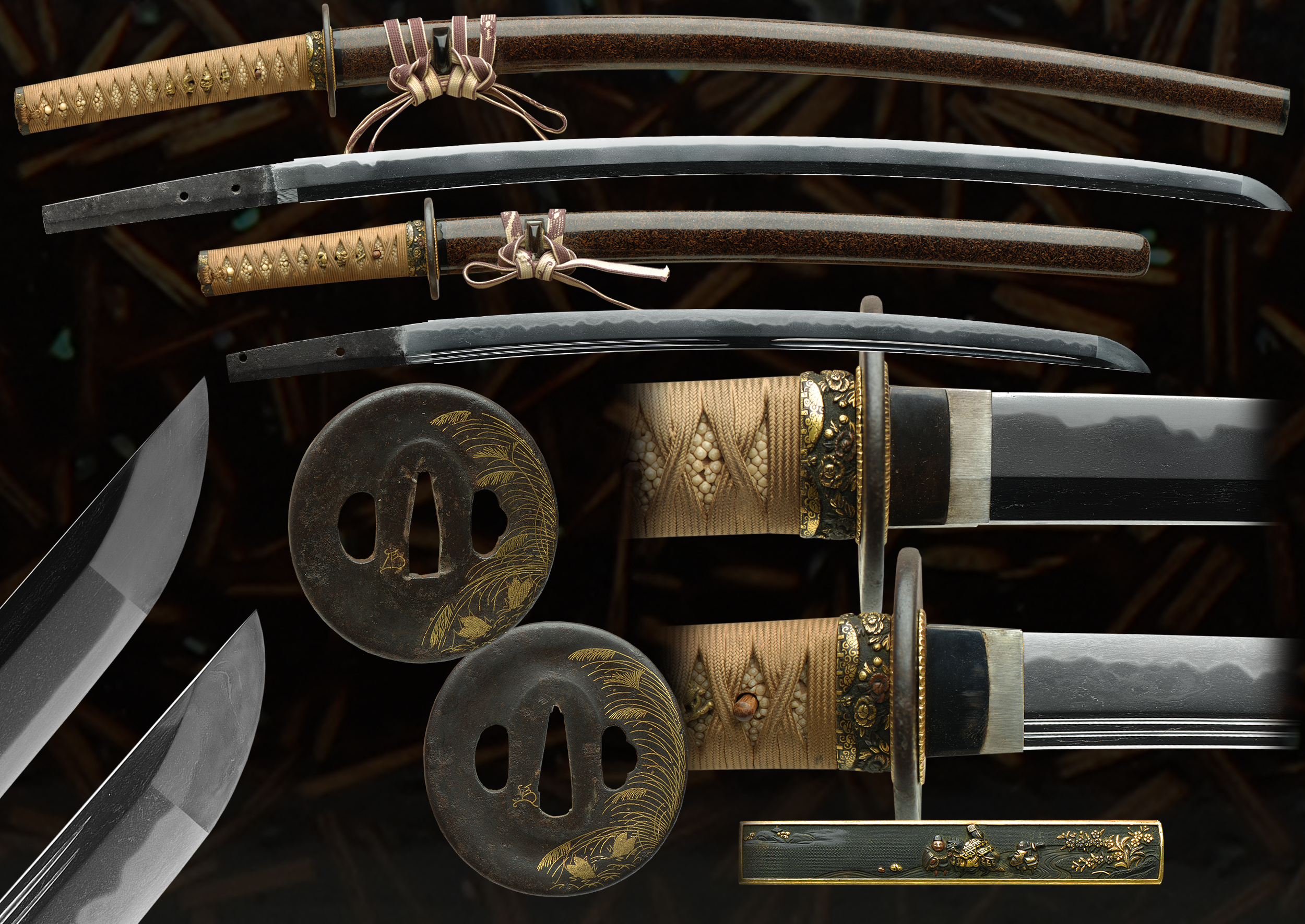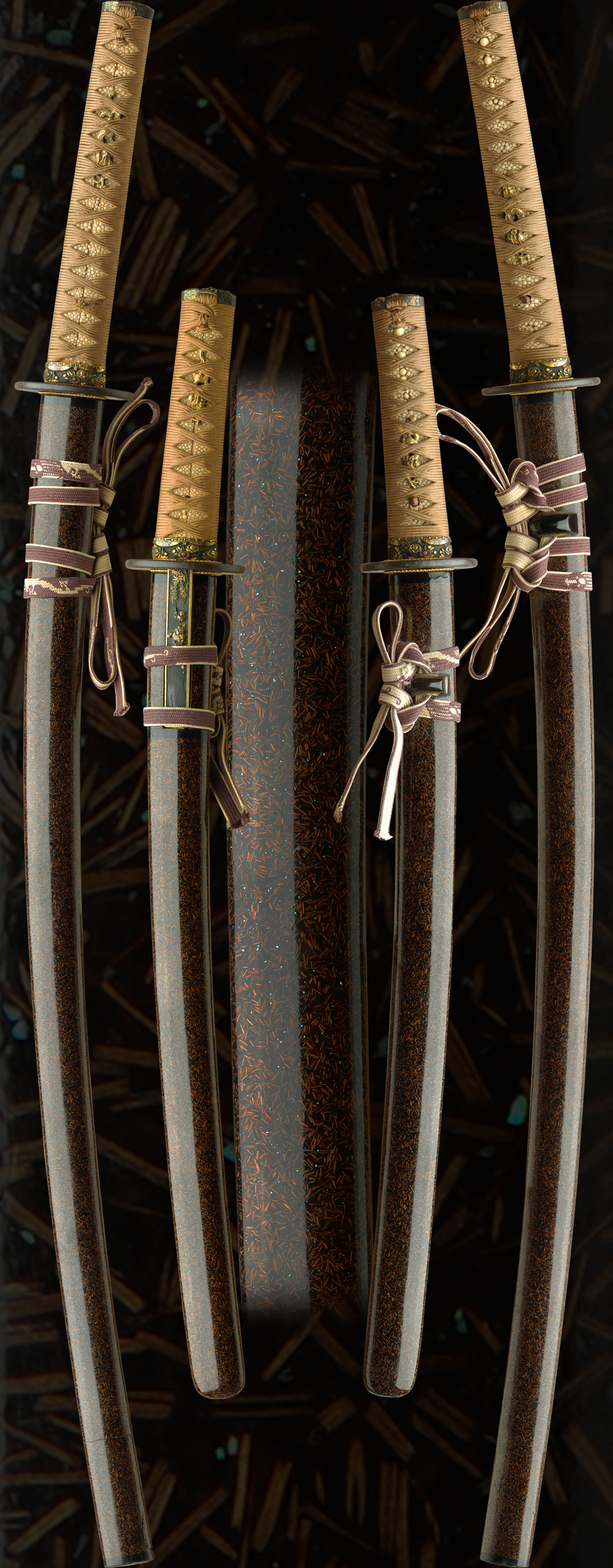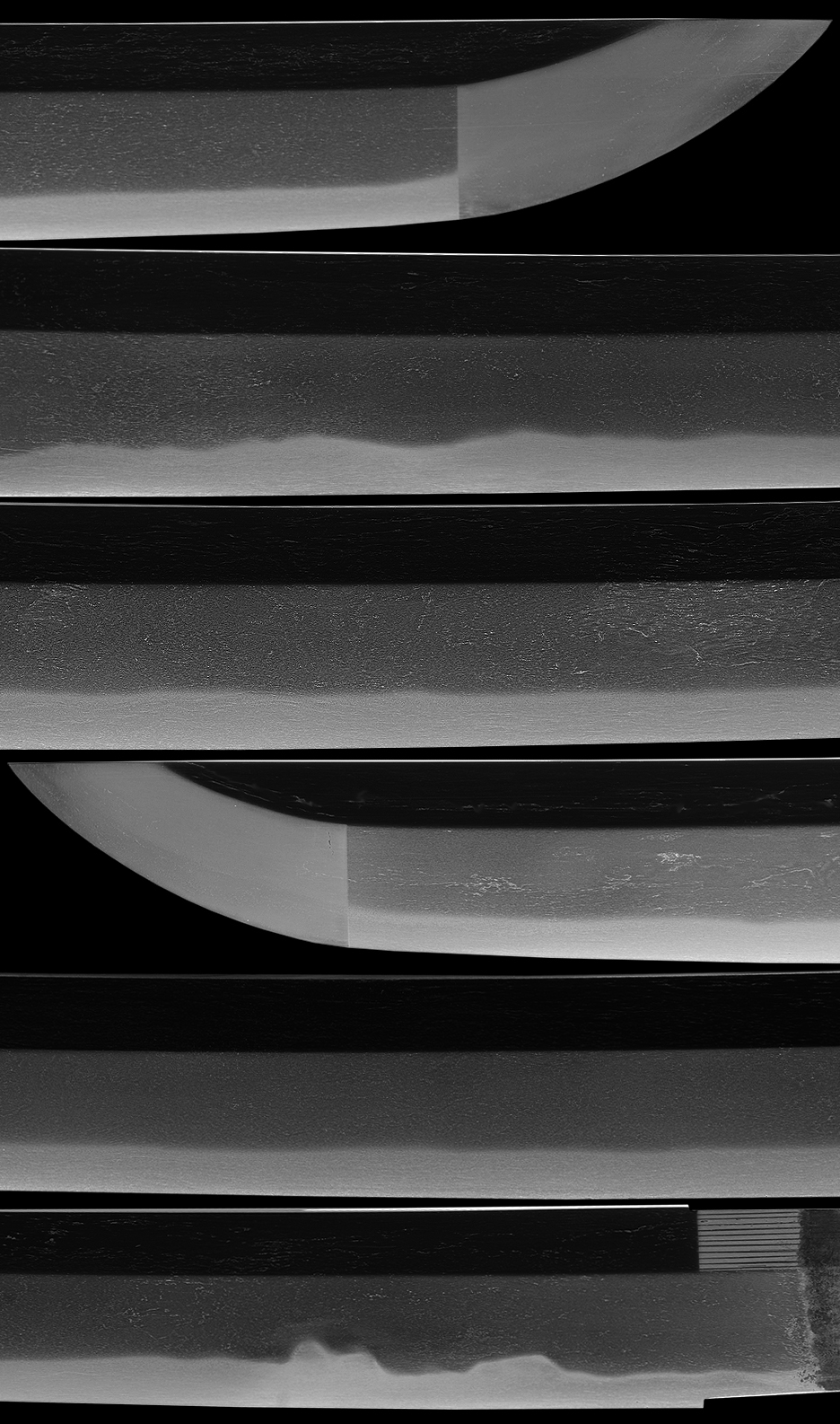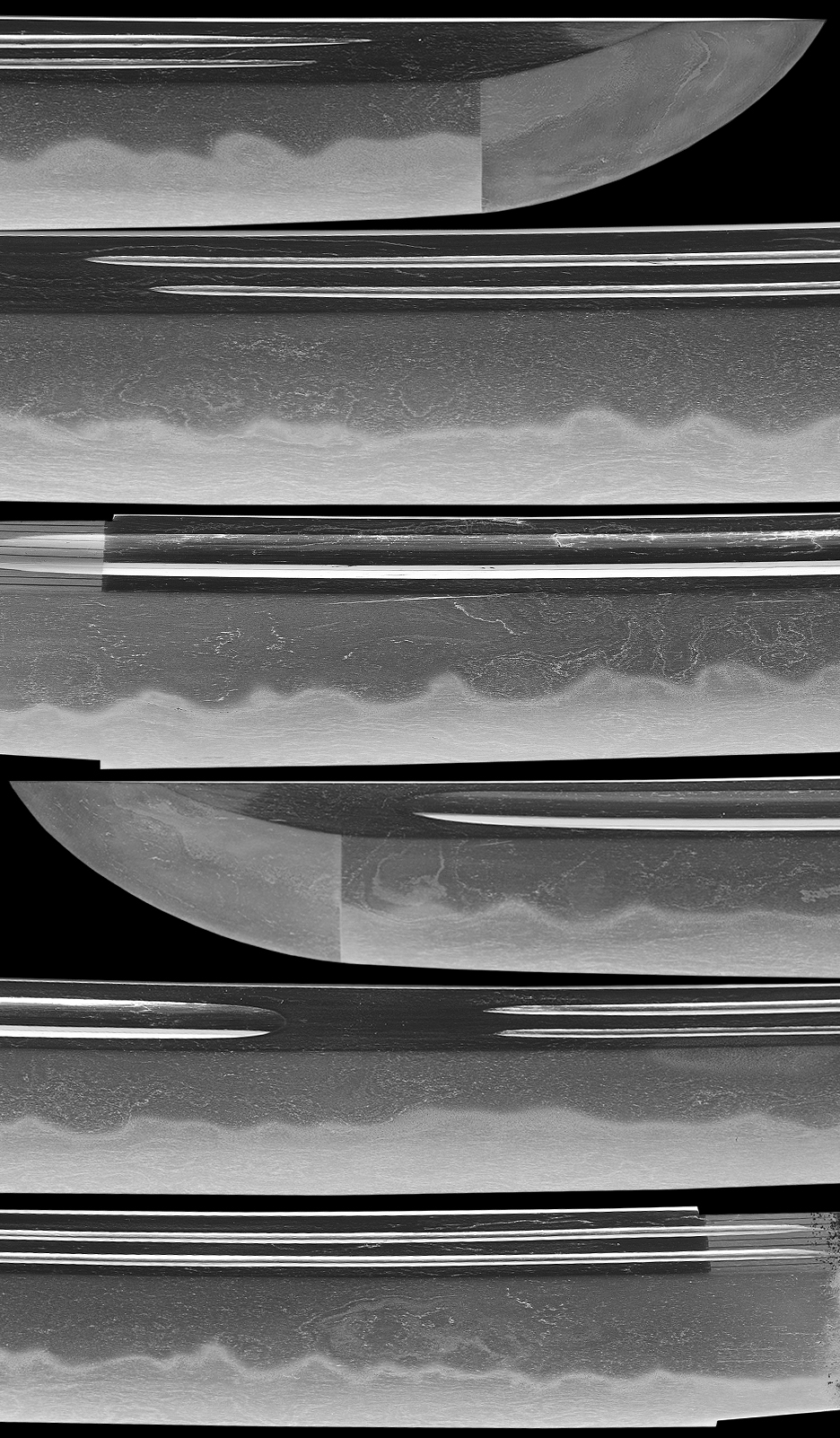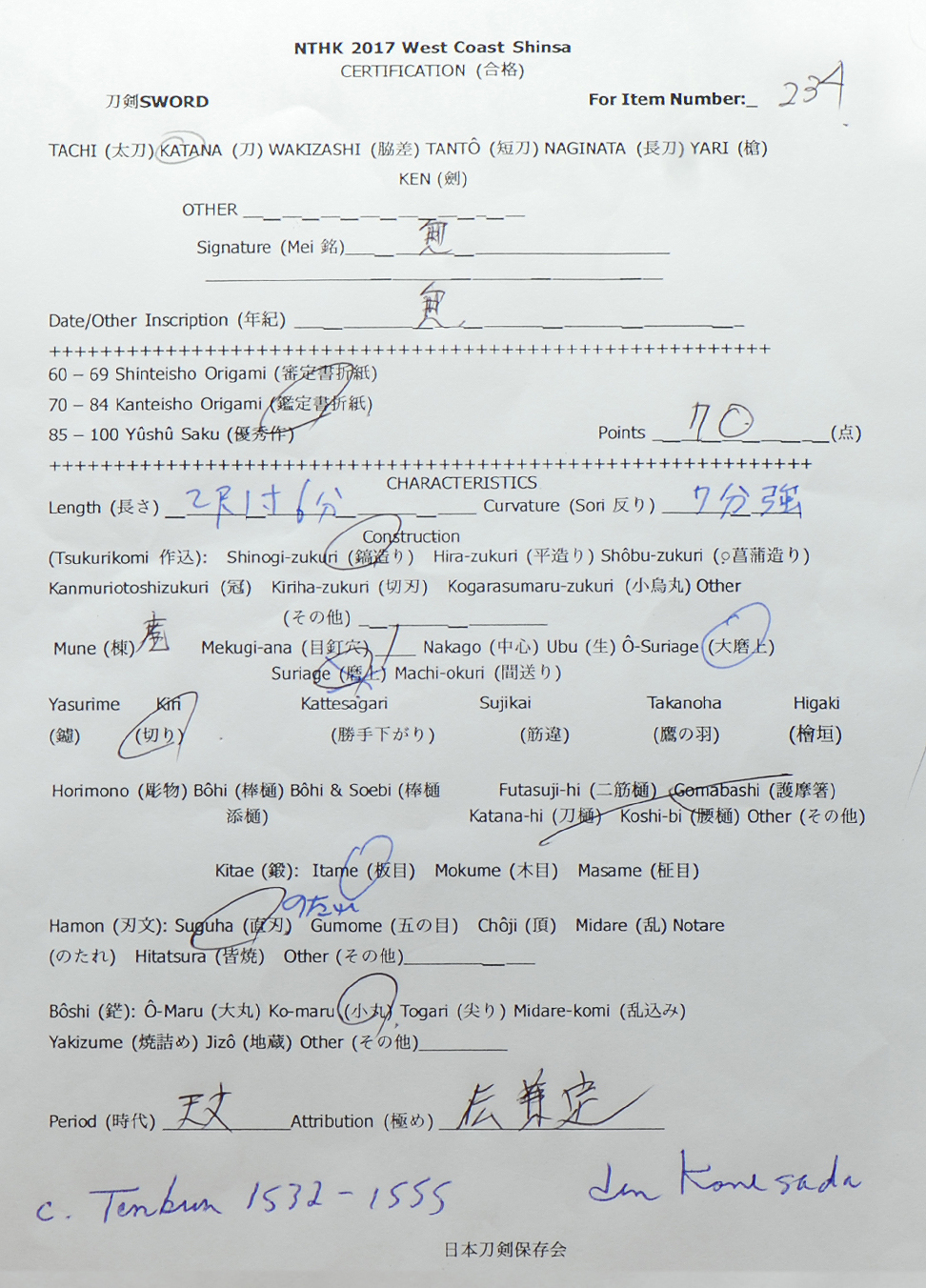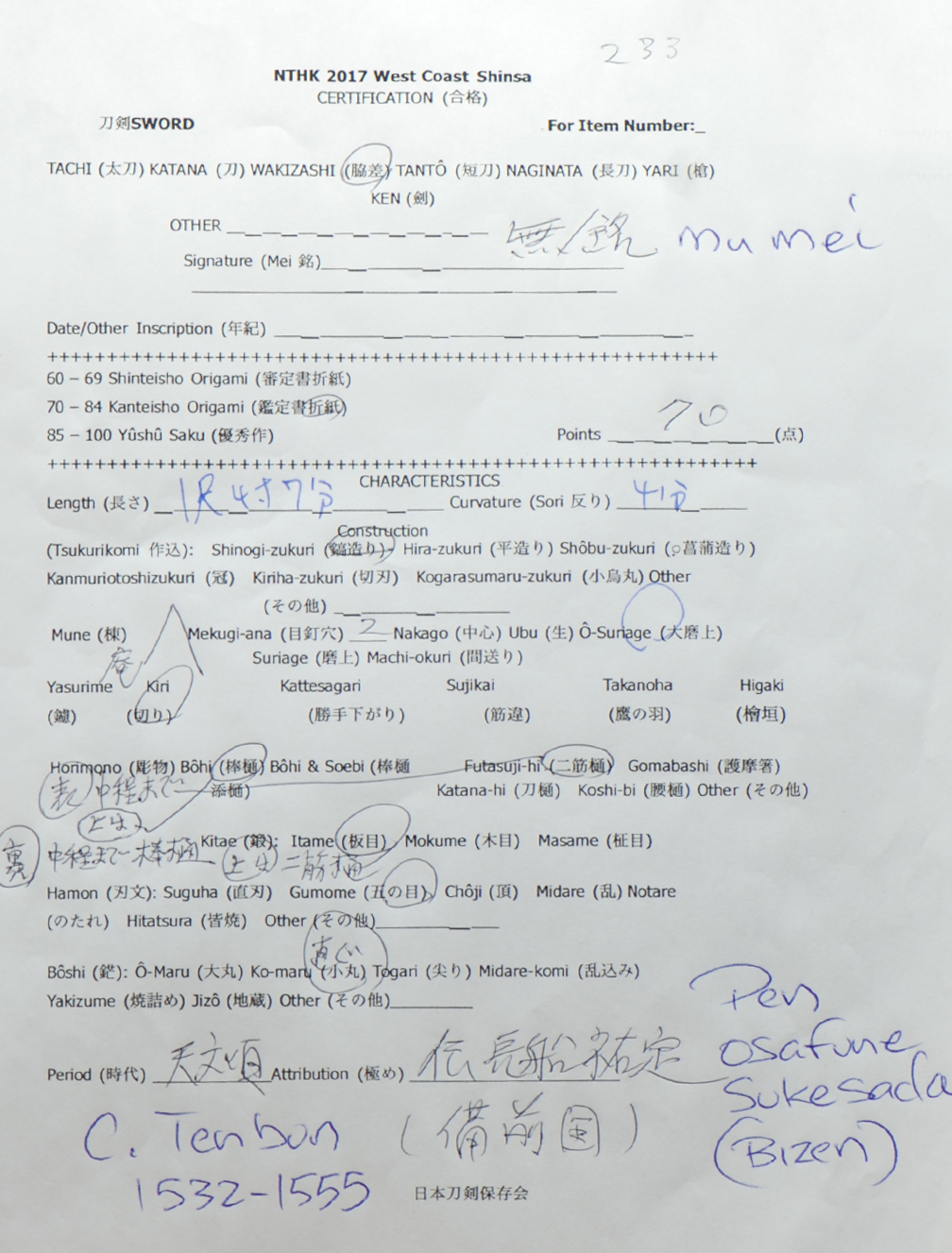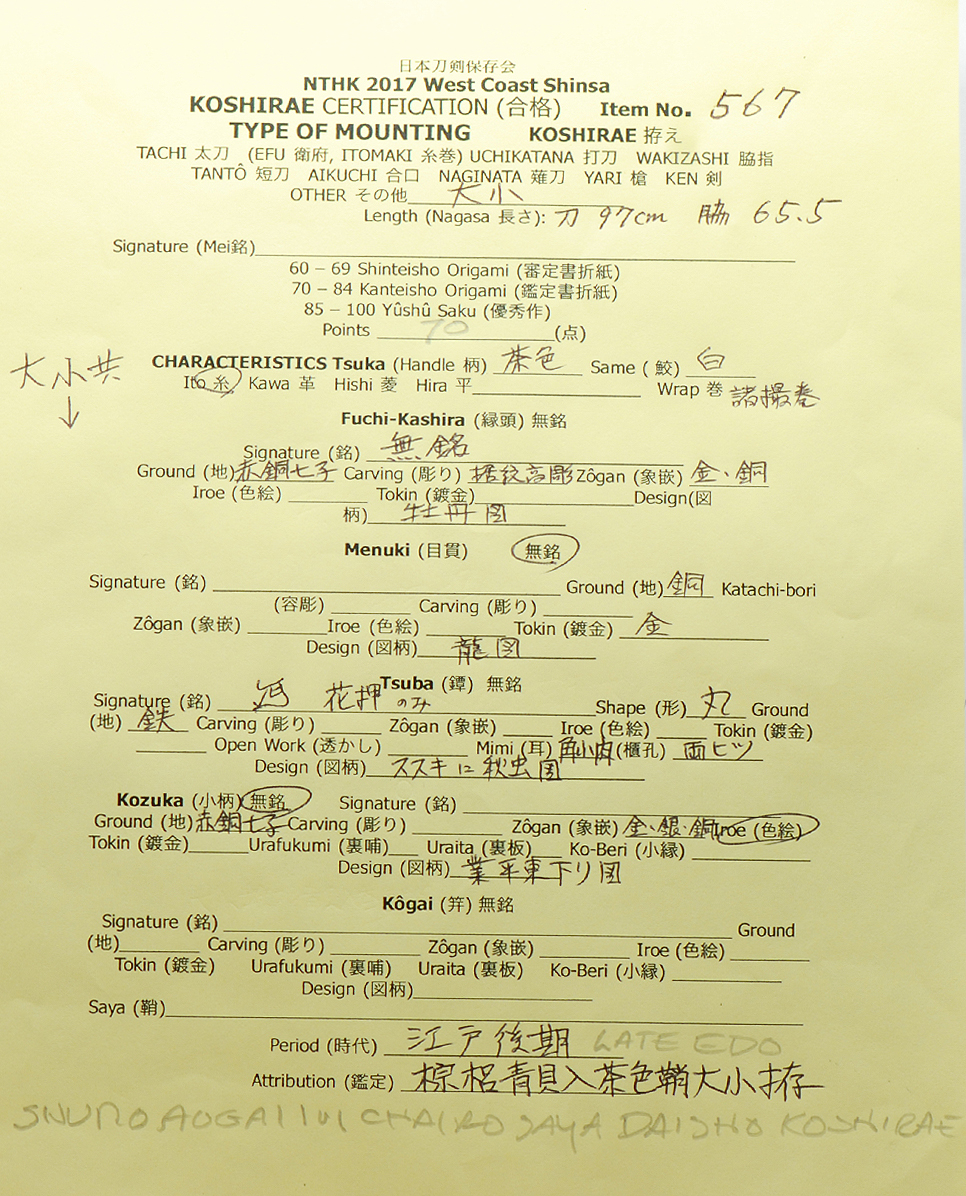A True Samurai Daisho, These swords, both Koto pieces (1500’s era) are mounted in a spectacular pair of original Edo period mounts with inlayed style lacquered saya accentuated with abalone throughout. The Motif is of a floral design framed within a textile like curtain and are in pristine condition. The flowers that are used are called Paulowinia, it is a flower pattern referred to in Japanese as Go-Shichi-No-Kiri and was used to represent the Prime minister of Japan in later times. The Menuki are of gold washed dragons and the Kozuka is of a scholar or monks traversing their way to a town in the distance, a very cool scene indeed and quite nice.
The Tsuba are of iron with gold inlay of the Musashi plains grass with small winged insects at the bottom both with gold Mon to the maker. The Same or rayskin is of very high quality with a large pattern nodule exposed. The ito is a goldish brown and the sageo is mauvish and white with dragon motif. These sageo with dragon weaved in them are fragile and very old. They are very unique.
The Daisho habaki are both 2-piece with shakudo foil bases and the tops are of silver foil both original to the blades and matching.
The Dai-to was attributed to Den Kanesada. A beautiful blade in pristine polish and loaded with activity from the koto period an O-suriage piece. Within the Sugu-ha there is hotsure, sunagahi and kinsugi. The hada is a dense and beautiful swirling itame and mokume mix. The hada has some course areas that stand out as in many koto era blades. The KANESADA line of sword smiths of the Mino school are the most famous craftsman of Sue-seki along with KANEMOTO. KANESADA the Second generation, often called Nosada, is still very much-prized as Owazamono. This blade has an attribute of KANESADA most likely a later generation smith of this line. This sword is more than likely early koto to mid koto era. At the head of the school was Mino Kanemoto and Kanesada,there are many sword smiths in Mino province that used this name.The most famous sword smith is 2nd generation ” Izumi Kami Kanesada”.
The Sho-to was attributed to Bizen Den of the koto period. An O-suriage piece this sword has a hamon based in midare-ba throughout with an incredible amount of hataraki. The hada is an itame nagare with ji-nie and some Masame. The sword has a very rare version of horimono in the form of bohi on both sides. One side is a double set of gomabashi while the other side sports a set of gomabashi with a wide single Bohi also.
“According to Nagayama Bizen-den begins at the end of the Heian Period with the Ko-Bizen School and carried on by the Ichimonji School. Mid-Kamakura period we see the rise of the Osafune School. Nagayama divides discussion of Bizen into two main areas; 1) by main school and change over time, 2) by leading swordsmiths. This discussion will only attempt to summarize the main schools and change over time.”
Late Heain Period – Early Kamakura:Ko-Bizen has choji-midare in nioi-deki. See influence on Yamato-den with hamon based on suguha mixed with ko-midare and ko-choji in nie deki. The hamon then evolves into one based on midare, hada is mokume, chu-mokume or ko-mokume. Jifu utsuri is often seen. Finally choji-midare in nioi completed by the Fukuoka Ichimonji School.
Middle and Late Kamakura Period:Jigane is soft and well forged, mainly mokume with some o-hada patterns, midare-utsuri or choji-utsuri, some ji-fu-utsuri. Other items remain the same for the most part from the previous period. Boshi is midare-komi, ko-midare and ko-maru.
Nambokucho Period:The shape now reflects the grander style of the period, longer swords with longer kissaki. Workmanship begins to reflect the So-den, or soshu style. Jigane is some, has utsuri and o-mokume hada combined with dark jigane that looks like “swimming catfish” (don’t even ask me what that means). There is also ko-mokume hada which stands out and also has utsuri. Hamon, if wide, loses its utsuri. Hamon changes and we begin to see notare-midare and saka-midare forms. Boshi is usually midare komi, in proportion to the hamon but kaeri seems to getting longer.
Early Muromachi Period:Shape now reduced in size from previous period, return to style of Kamakura period. Sori inclined to sakizori (which is different from the koshizori of earlier times). Hamon is koshihiraita midare with choji-midare. Utsuri is now straight. Also see some midare and suguha.
Late Muromachi Period:Hada loses it appearance of wetness/oiliness. Utsuri is now rarely seen and if seen is no longer distinct. Koshihiraita midare with special variety known as crab-claw choji. Considerable nie in the hamon. Nie kuzure is seen. Scattered nioi.
Both swords are mounted in shirasaya to protect the polish and the koshirae have wooden tsunagi for displaying and storage.
” The wearing of daishō was limited to the samurai class, and became a symbol or badge of their rank. Daishō may have became popular around the end of the Muromachi period (1336 to 1573) as several early examples date from the late sixteenth century.An edict in 1629 defining the duties of a samurai required the wearing of a daishō when on official duty. During the Meiji period an edict was passed in 1871 abolishing the requirement of the wearing of daishō by samurai, and in 1876 the wearing of swords in public by most of Japan’s population was banned; this ended the use of the daishō as the symbol of the samurai, and the samurai class was abolished soon after the sword ban.
- KATANA
- Mei: Mumei
- Date: Tenbun (1532-1555)
- Nagasa: 26″ inches
- Sori: 21.0 mm
- Width at the ha-machi: 30.8mm
- Width at the yokote: 20.7 mm
- Thickness at the mune-machi: 7.4mm
- Construction: Shinogi zukuri
- Mune: Iori
- Nakago: O-suriage
- Kitae: Itame
- Hamon: Sugu / Gunome
- Boshi: Ko-Maru
- Condition: Good polish
- WAKAZASHI
- Mei: Mumei
- Date: Tenbun (1532-1555)
- Nagasa: 17-1/2 inches
- Sori: 12.0 mm
- Width at the ha-machi: 29.0 mm
- Width at the yokote: 20.5 mm
- Thickness at the mune-machi: 7.0 mm
- Construction: Shinogi zukuri
- Mune: Iori
- Nakago: O-suriage
- Kitae: Itame
- Hamon: Gunome
- Boshi: Ko-Maru
- Condition: Good polish
Email us if your interested in this item and remember to include the order number for this item: fss-759.
Click to Enlarge Image
KATANA
Click to Enlarge Image
WAKAZASHI
This Daisho has recently passed shinsa. These are the work sheets, the official papers will take a few month to be made and sent from Japan. These papers will be forwarded to the new owner when this sword sells.
Note that this sale item has three certificates. Each sword has a certificate and the Daisho koshirai have papers. Put together Daisho will not receive certification, only a true original set will receive certification.
Click to Enlarge Image
Katana NTHK Certificate
Click to Enlarge Image
Wakazashi NTHK Certificate
Click to Enlarge Image
Koshirai/Mounts NTHK Certificate
For Sale





















